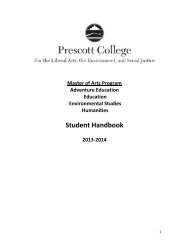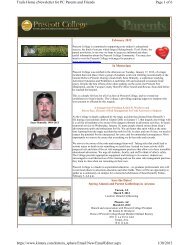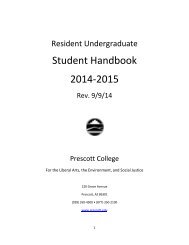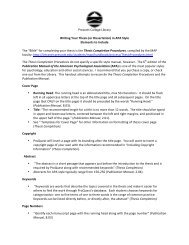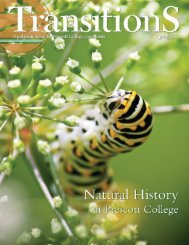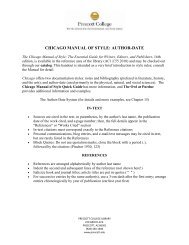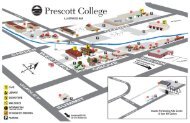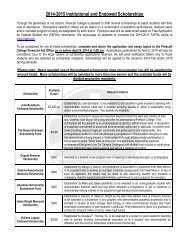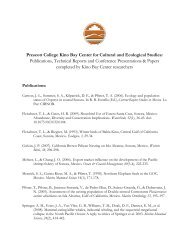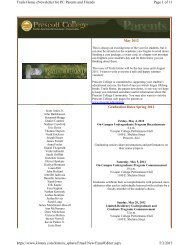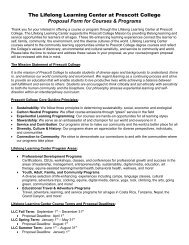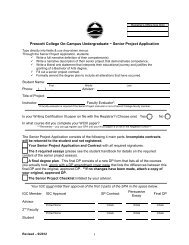Transitions Magazine Fall 2011 - Prescott College
Transitions Magazine Fall 2011 - Prescott College
Transitions Magazine Fall 2011 - Prescott College
- No tags were found...
You also want an ePaper? Increase the reach of your titles
YUMPU automatically turns print PDFs into web optimized ePapers that Google loves.
Women’s Studies at <strong>Prescott</strong> <strong>College</strong>:The BeginningsBy Lisa Stewart Garrison ’75By the late 1960s and early 70s, as feminism swept thecountry, dramatically changing what women expectedof themselves and each other, the seeds of the women’smovement were taking root at <strong>Prescott</strong> <strong>College</strong>. With its slogan“the personal is political,” feminism was primarily impacting urbancenters. Few would have predicted that young women at a secludedcollege campus in the chaparral country of the Granite Dells ofCentral Arizona might be emboldened to develop courses of studyand ways of living and talking together that would contribute to thebroader movement and transform the lives of those of us involved.In many ways, fertile ground for women’s empowerment wasin place by 1968 when <strong>Prescott</strong> <strong>College</strong> formally launched itssignature three-week Wilderness Orientation Program. The firstcadre of young women participated in intensive hiking, kayaking,river rafting, and mountaineering; faced physical challenges, tookrisks, and engaged in cooperative teamwork, gaining newfoundconfidence in their strength and problem solving abilities. Threedays spent alone in the wilderness nurtured qualities of self-relianceand a sense of spiritual connection with nature.Yet as classes formally began, womenstudents quickly learned that experiencingcompetence in wilderness settings andknowing how and when to use words toconfront sexism were very different things.At <strong>Prescott</strong> <strong>College</strong>, in that era, men greatlyoutnumbered women on the faculty and in thesyllabi. Out of a faculty of 37, only three werewomen. As women students we embraced<strong>Prescott</strong>’s philosophy of taking individualresponsibility for directing one’s own education.We were learning to read maps and tomap out our lives. But we were also searchingfor role models and determined to find facultyon campus to help us articulate our insights.<strong>Prescott</strong> <strong>College</strong>’s first women’sconsciousness raising group met at theschool’s newly opened Center for thePerson on October 19, 1970. We foundour faculty mentor in Heather Keen(now Heather Starsong), who hadarrived on campus to teach moderndance and establish ayoga program.A group of 12 to 15 of us met weekly,throughout the year, verbalizingfeelings and perceptions previouslyleft unsaid, grappling with our increasinganger, and finding our commonground as women.Although at first reluctant to serve in an advisory capacity,Heather stepped in, on condition that we accept her as a fellowlearner, since she didn’t claim this issue to be within her area ofexpertise. Feminism was focusing on women and their bodies atthat time, but the emphasis was on reproductive rights, access to8<strong>Transitions</strong> <strong>Fall</strong> 2014healthcare, sexuality, and self-defense. Heather’s commitment toembodiment through improvisational dance and the inwardjourney set a distinctive tone for our explorations. She invitedspecial guests to meet with us, such as the ritual and ceremonymaker Elizabeth Cogburn. Heather’s grounded presence in aturbulent time of intense social awakening demonstrated for uswhat it is to be an emotionally courageous woman.The provocative influence of feminist theory and theintellectual firepower ofPeggy Rourke and Sarah White, 1972, by Beliz Brotherconfrontation were aliveand well among womenat <strong>Prescott</strong> <strong>College</strong> inthe early 1970s. A feministcritique of theOrientation Programbegan to emerge. Giveus experiences that leadus out of our comfortzone, by all means. ButOutward Bound’s creedthen—“To Strive, ToSeek, To Find, and NotTo Yield” (Alfred Lord Tennyson)—evoked a summit mentality, a push forthe peak, and an unwillingness to surrenderthat was increasingly discomfitingto women.A group of us set up a feministdorm. Hot-off-the-press feministmanifestos, forwarded to us by mysister in California, were coveted likecontraband. Dog-eared copies of thewomen’s newspaper Off Our Backs werepassed from room to room. We wereyearning to read literature by womenand to find heroines whose journeysmight inspire our own.In the fall of 1971 fellow women students approached me toteach the <strong>College</strong>’s first women’s literature class. We organizedourselves as an Independent Study with Heather Keen andliterature professor Dr. Stan Witt serving as faculty advisors. Bythe following spring, 25 women were enrolled.We supplemented a syllabus of novels by women withreadings of feminist theory and criticism, acquired throughpilgrimages to bookstores in Phoenix and Berkeley. We weremaking our way through the writings of Shulamith Firestone, KateMillet, and Robin Morgan. The poetry books of Sylvia Plath, AnneSexton, and Judy Grahn were on perpetual reserve for us in thelibrary. Throughout the spring of 1972, we met each Mondayevening in an old grey farmhouse off campus (then home to agroup of <strong>Prescott</strong> students and their small herd of goats).Inspired by our readings, our conversations ranged fromwomen’s changing identities, to women loving women, andWomen’sLiterature at<strong>Prescott</strong> <strong>College</strong> was myentry point to everything. Whatwe read and talked about, wherewe met, who we understoodourselves to be, opened the doorto what I would study, whom Iwould love, how I would liveand work.—Melanie Lohmann ’75Lisa S. Garrison, 1972



